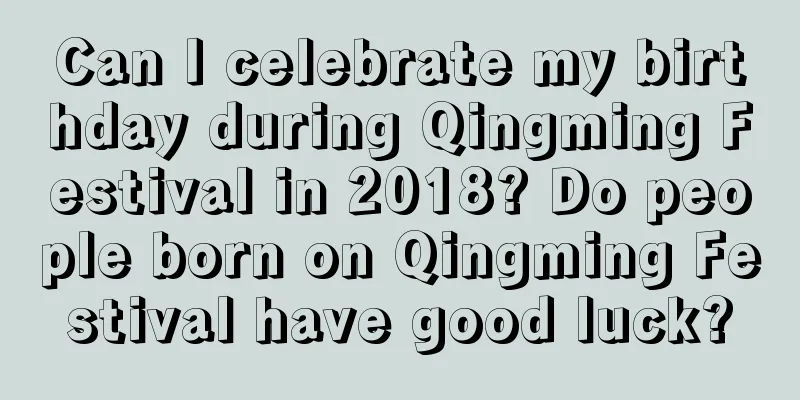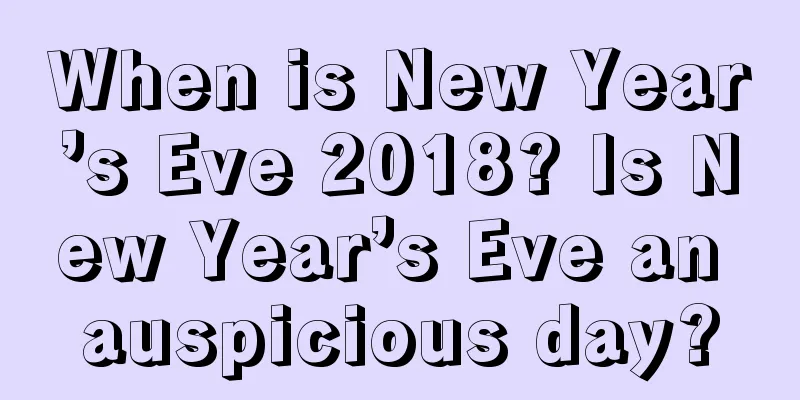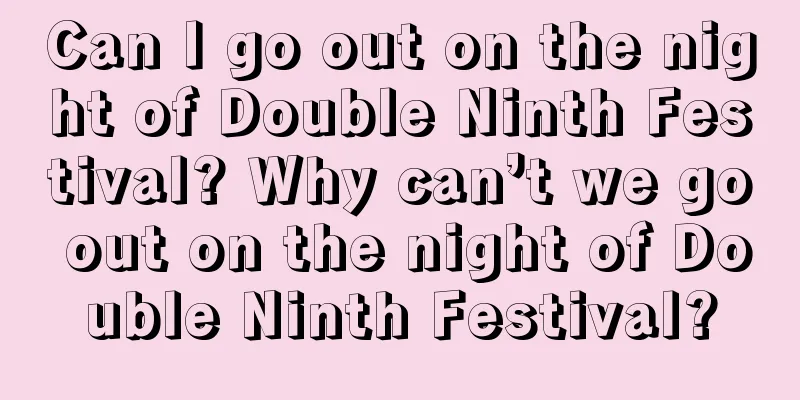What customs did ancient people have on New Year's Eve? Interesting stories about ancient people's New Year's Eve customs

Introduction: New Year's Eve occupies a very important position in our traditional festivals, and New Year's Eve has many customs and habits. New Year's Eve has been a tradition among us for a long time, so how did the ancient people celebrate it? Are there any customs and habits? Now, follow the editor to gain more knowledge. There are not only many national customs and activities on New Year’s Eve, but also many New Year’s etiquette and taboos. Want to know more? Welcome to the New Year’s special topic carefully prepared for you by Mr. Shui Mo to learn more!1. ExorcismIn the Song Dynasty, exorcism rituals were divided into major Nuo rituals and minor Nuo rituals. The most popular ritual in the palace was the Grand Nuo ritual. According to the explanation of people in the Song Dynasty, the purpose of the Da Nuo is to drive out all the negative energy and guide it to the yang. Nowadays, people beat drums to drive away the plague on the day before the twelfth lunar month, which is called "Zhu Chu". Meng Yuanlao's "Dongjing Menghualu" records that on New Year's Eve, a grand Nuo ceremony was performed in the palace, and officials from the imperial city were employed. The guards wore masks, embroidered clothes, and held golden spears and dragon flags. Meng Jingchu, the director of the Imperial Music Bureau, had a tall and strong figure, wearing a full set of gold-plated copper armor, and dressed as a general; he used two generals to guard the palace, also in armor, and dressed as door gods; Nan Hetan, an ugly and fat person from the Imperial Music Bureau, dressed as the judge; there were also people who dressed up as Zhong Kui, Xiaomei, the land god, the kitchen god, and so on, a total of more than a thousand people. To drive away the evil spirit from the confinement, go out of the Nanxun Gate and turn the Dragon Bend, which is called burying the evil spirit. Compared with other historical records, the Lin'an Nuo exorcism ceremony during the Southern Song Dynasty was generally the same.2. Send festival giftsAccording to historical records, the emperors of the Song Dynasty had the custom of bestowing the statue of Zhong Kui on civil and military officials on New Year's Eve. For example, during the reign of Emperor Shenzong of the Northern Song Dynasty, Emperor Shenzong ordered painters to copy the image of Zhong Kui, and then after engraving and printing it, he gave the finished product to officials in the Secretariat and the Privy Council. On New Year's Eve, Emperor Shenzong sent officials to the East and West Palaces to bestow the statue of Zhong Kui. Among the common people at that time, there was also the custom of sending door gods, Zhong Kui and other festival gifts. For example, the Song Dynasty historical notes "Jiliebian" recorded that on New Year's Eve, when sending festival gifts, two large bamboo poles must be placed along with them.3. New Year's Steamed BunsHuotu is a special snack made on New Year's Eve in the Song Dynasty, similar to today's mutton soup with steamed buns and other soup-like foods. People in the Song Dynasty had the term "winter wonton" and "New Year's wonton". The great poet Lu You wrote in his poem "New Year's Day Events": At mid-evening, the remaining steamed buns are distributed, and at dawn, people get up to exchange for Zhong Kui. He also made a note: In the local custom, the sacrifice is completed at midnight, and the old and the young eat the rest together. Also, soup noodles are a must-have on New Year's Day, which are called winter wontons and Nianwutuan.4. Test your ageLu You's "Jiannan Poetry Draft" says: According to the local custom, people gather together to gamble every year, which is called testing one's age. The winnings and losses of gambling on New Year's Eve are regarded as a game to predict people's fate in the coming year. In addition, the line "playing Hulu under bright candles" in Lu You's poem "New Year" refers specifically to this game.5. Midnight snack fruitOn New Year's Eve, the whole family gathers together. In order to kill the leisure time at night, many families in the Song Dynasty would prepare some midnight snacks, also called midnight fruit. For example, the book "Menglianglu" describes the scene of midnight fruit snacks in the palace. It says: On that day, the Nei Si Yi Bureau presented an exquisite midnight fruit snack package, which contained various fine fruits, seasonal fruits, fried fruits with honey, fried fruits with sugar, and market food, such as ten kinds of sugar, Chengsha balls, rhymed fruits, honey ginger and fermented black beans, soap cakes, honey crisps, small abalone crisps, market cakes, five-color beans, fried chestnuts, ginkgo, etc., as well as small toy heads, signs, and cards. It was used for the princes and ladies in the palace to play with and eat. Although the meals in ordinary people's homes could not be as sumptuous as those in the palace, they also tried their best to prepare midnight snacks and fruits to ensure a smooth New Year.6. Children selling dementiaAccording to the customs of the Song Dynasty, before dawn on New Year's Eve, an activity called "children selling dementia" would be held. The Southern Song poet Fan Chengda described it in his poem "Selling Idiot Poems": People stay up late on New Year's Eve, tired of getting rid of the dullness and welcoming the new year. A child was shouting along the long street, saying that he had a dementia and was looking for someone to buy him. Who is the only one who does not have these two things or people? Among them, Wu Yi still had some left, and people in the alleys south and north could not sell them. When people met them, they laughed and teased each other. The old man Li sat alone under the heavy curtains, wanting to buy more and asking the price. The son said: "Old man, you don’t have to pay for it. I’ll be stupid for a thousand years if I buy it on credit!" From this seemingly humorous poem, we can see that this custom is full of the good wishes of the people in the Song Dynasty, that is, they all hope that their children can be smart.7. Ash PileWhat people in the Song Dynasty called "beating the ash pile" probably meant taking a bamboo pole hung with copper coins and hitting the ash pile or garbage pile hard before dawn. It is said that after beating the ash pile, the owner of the house will turn misfortune into good fortune, and many of his wishes will come true, so it is also called "hitting the wish list".8. BasketBurning pine basins was mainly a folk activity in the Song Dynasty to exorcise evil spirits and pray for good luck. It became popular in the Southern Song Dynasty. Zhou Mi's "Wulin Jiushi" recorded that on the night of (New Year's Eve), candles were lit in pots and lanterns, and the sky was illuminated with red. The "籸盆" is so called because it uses hemp residue as fuel. Liu Changshi's "Lupu Notes" also records: Nowadays, when people hold sacrifices in temples or banquets, they often use a high platform with burning firewood to illuminate the courtyard, which is called a "shengpen". No one knows its meaning. When I was on duty in the palace, I saw fire basins on both sides of the imperial road filled with hemp rice. Then I realized that they were fire basins, commonly known as "sheng" (raw rice basins).9. Burning AtractylodesAtractylodes is a traditional Chinese medicine. People in the Song Dynasty believed that it has the effect of eliminating dampness and strengthening the spleen and stomach. Therefore, in the Song Dynasty, on every New Year's Eve, most people would burn medicinal herbs such as Atractylodes lancea in the hope of warding off plague and dampness and praying for health. As Zhou Mi's "Wulin Jiushi" records: On (New Year's Eve) night, things like drinking Tusu, Baishiji, and gum candy, burning magic and selling Meng, etc., are mostly the legacy of the Eastern Capital (referring to the Northern Song Dynasty). It can be seen that this practice of burning Atractylodes lancea was passed down in both the Northern Song Dynasty and the Southern Song Dynasty.Summary: Through the above article, we know about some customs and habits of ancient people in celebrating New Year’s Eve, which are also very rich and colorful. I hope you like the above article. I wish you all a happy reunion on New Year’s Eve, and a safe, smooth and prosperous new year! |
<<: How to place balcony plants during the 2017 Spring Festival to boost good fortune
>>: Seven Feng Shui tips to know during the Spring Festival
Recommend
Is the 28th day of the third lunar month in 2019 a suitable day for decoration? Analysis of Feng Shui for decoration in 2019!
Introduction: In our country's traditional cul...
Do girls born on Qingming Festival have good marriage fortunes? Can a girl born on Qingming Festival be married?
The fortune of girls born at different times is di...
How is it for rats born in October of the lunar calendar in 2020? Which day is best for people born in the Year of the Rat?
How is it for rats born in October of the lunar ca...
What is the date and day of November 14th in the lunar calendar in 2017?
In the eleventh month of the lunar calendar, whet...
Is Valentine’s Day 2020 an auspicious day? Check the auspiciousness and inauspiciousness of the time on February 14!
Introduction: Every day will have good and bad luc...
Is it not appropriate to talk about marriage on April 4, Qingming Festival in 2020? Is Qingming Festival a solar term?
Introduction: Generally speaking, it is necessary ...
How is the summer solstice calculated? When is the summer solstice?
The summer solstice is the earliest solar term to ...
Can I travel during the Ghost Festival in 2019? What festival is on the 15th day of the seventh lunar month?
Introduction: It is usually necessary to choose an...
What are the auspicious days in May of 2018?
Introduction: People like to look at the almanac w...
Is it a good idea to pick up the car on April 17th of the lunar calendar in 2018?
April is the most beautiful month in the world. A...
Is the sixth day of the second lunar month in 2020 a good day? What date is it in the new calendar?
February 6, 2020, is the sixth day of the second ...
What are the poems about the Rain Water solar term?
The Rain Water solar term means that spring has ar...
Is the 25th day of November in the lunar calendar in 2021 an auspicious day? Can I install a door?
The eleventh month of the lunar calendar is also k...
Analysis of the 13th day of the second lunar month in 2021, is it an auspicious day?
Some days are good, while some are bad, but not al...
Is September 29th of the lunar calendar in 2021 a lucky day? Is it an auspicious day?
The ninth month of the lunar calendar is the third...









